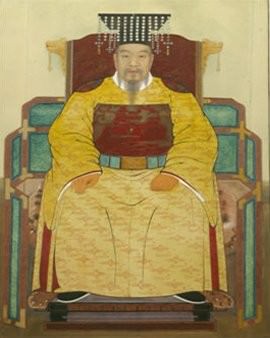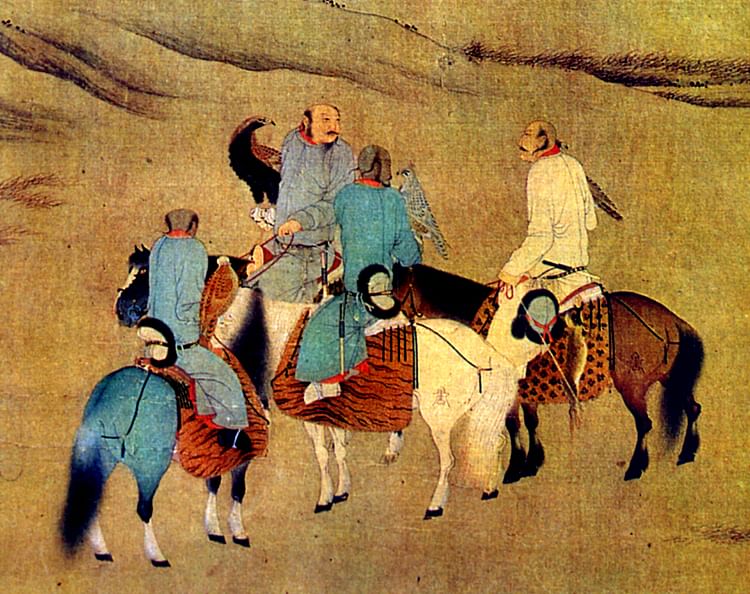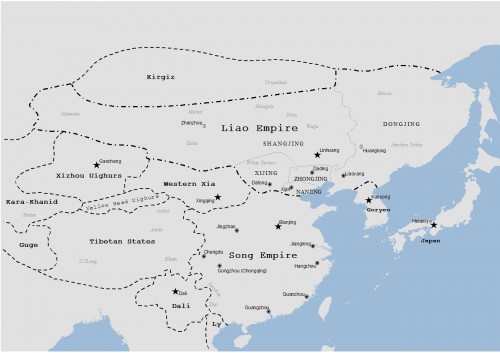Later Three Kingdoms Period › Khitan » Ancient origins
Articles and Definitions › Contents
- Later Three Kingdoms Period › Ancient History
- Khitan › Ancient History
Ancient civilizations › Historical and archaeological sites
Later Three Kingdoms Period › Ancient History
Definition and Origins

The Later Three Kingdoms period (889-935 CE) of ancient Korea saw a partial revival of the old three kingdoms which had dominated the peninsula from the 1st century BCE to the 7th century CE. After the Unified Silla kingdom had ruled Korea alone from 668 CE, it slowly began to decline and the power vacuum this created led to several rebellious states rising up and taking on the old historical names of Korea's ancient kingdoms. A messy period of alliances and in-fighting followed, but one state would once again establish a dominant position – Goryeo, itself named in homage to the earlier northern Goguryeokingdom – and form a unified Korean state and a dynasty which would last for over 500 years.
THE FALL OF SILLA
The Unified Silla Kingdom (668- 935 CE) had held sway over the Korean peninsula for three centuries, but the state was in a slow decline. The rigidity of its class structure based on the Bone rank system meant that few could rise above the position of their birth and ideas and innovation were stifled. The aristocracy began to resent the power and waste of the king, landowners resisted centralised control, and the peasantry grew more and more rebellious over the incessant taxes levied upon them. The state was falling apart from within.
The weakness of the central Silla government meant that local warlords and strongmen, always difficult to bring under state control at the best of times, now ruled their own territories as they pleased. Banditry swept across the peninsula with particularly infamous villains being Chongill, Kihwon, Yanggil, and a group known as the Red Pantaloons ( Chokkojok ).
GYEON HWON & GUNG YE
This period of political turmoil which turned into a free-for-all for control of Korea is referred to as the Later Three Kingdoms period (889-935 CE). Gyeon Hwon (Kyon Hwon, 867-936 CE), a peasant leader and Silla army officer, took advantage of the political unrest in 892 CE and made himself military governor of the city of Muju. By 900 CE Gyeon became more ambitious and, joining forces with the bandit Yanggil, formed a revival of the old Baekje ( Paekche ) kingdom in the south-west portion of the peninsula. He chose Wansan (modern Chonju) as his capital.
ONE THING THAT NEVER CHANGED WAS GUNG YE'S HATRED OF SILLA & HIS INSISTENCE THAT HIS SUBJECTS ALWAYS REFER TO IT AS THE 'NATION OF THE DAMNED.'
Meanwhile, an aristocratic Buddhist monk leader, Gung Ye (Kungye), declared a new Goguryeo ( Koguryo ) state in the north in 901 CE, known as Later Goguryeo ( Hugoguryo ). Gung Ye was either the illegitimate son of king Kyongmun or king Honan depending on the account. He, too, had formed an alliance with Yanggil but proved rather more ruthless and killed the bandit, clearing the way to declare himself king in his own right. His capital was first at Songak (Kaesong) and then Chorwon. He also twice changed the name of his kingdom – to Majin in 904 CE and Taebong in 911 CE – illustrative of his unstable character.One thing that never changed was Gung's hatred of Silla and his insistence that his subjects always refer to it as the 'nation of the damned.'
There then followed a protracted power struggle for control of the peninsula. Gyeon Hwon attacked Gyeongju, the Silla capital, in 927 CE, while Gung Ye's unpopular and fanatical tyranny led to his death at the hands of his people. Gung had become drunk on power and believed himself to be the Maitreya Buddha, spent his time composing sutras, dressed himself and his family in extravagant robes, and never went anywhere without an entourage of 200 monks chanting in his wake. He even claimed he had the power of mind-reading and used his 'skills' to purge his court of anyone he suspected of disloyal intentions. Gung was succeeded in 918 CE by his first minister, the able Wang Geon ( Wang Kon ) who probably had a hand in his hated predecessor's assassination. Wang had already distinguished himself as a naval commander, capturing several islands and blocking Baekje's trade with China and Japan. Wang selected the new name of Goryeo (Koryo) and moved the capital to Songak (modern Kaesong) where his father had long been a wealthy merchant and local headman.

Taejo of Goryeo (Wang Kon)
WANG GEON'S UNIFICATION OF KOREA
Later Baekje ( Hubaekche ) attacked the Silla kingdom in 920 and 924 CE. Silla, now the weakest of the three kingdoms and only controlling a small heartland in the deep south, responded by calling on Later Goguryeo for assistance. When Baekje attacked and sacked the Silla capital of Gyeongju in 927 CE, the Silla king Kyongjae (r. 924-927 CE) was forced to commit suicide and a puppet ruler, Kim Pu installed in his place with the reign name of Kyongsun. Wang responded by attacking the Later Baekje capital, which was now beset by leadership in-fighting. Gyeon Hwon then lost a battle at Kochang to a force led by Wang. Back at the Baekje capital, Gyeon faced a rebellion led by his son Singom, who, displeased that his father had favoured his younger brother Kumgang as next in line for the throne, imprisoned Gyeon at Kumsansa.
Wang was now in possession of most of Silla's territory, which he controlled via a new garrison outside Gyeongju, and his position as de facto ruler of Korea was recognised by the Tang dynasty of China in 932 CE. In 934 CE, after Wang's overwhelming victory over Baekje at Unju (Hongsong), refugees from the northern Manchurian state of Balhae ( Parhae ) felt the situation stable enough to return to Korea.
Kyongsun surrendered and named Wang as his successor in 935 CE, and in the same year Gyeon, who had escaped to Goguryeo territory, appealed to his old enemy Wang for help to remove Singom. Gyeon led a Goguryeo army to Baekje, and the resulting civil war and death of both Singom and Gyeon in 936 CE, greatly weakened Baekje and allowed Wang to finally unify the country once again under the name of Goryeo, origin of today's name for Korea. Wang, posthumously given the title of Taejo of Goryeo or 'Great Founder,' established a dynasty which would rule Korea for the next five centuries.
This article was made possible with generous support from the British Korean Society.
Khitan › Ancient History
Definition and Origins

The Khitan people formed the Liao dynasty and ruled parts of Mongolia, Manchuria, and northern China from 907 to 1125 CE. Adopting elements of Chinese government and culture, the Khitan were more than a match for their rivals the Song dynasty of China and Goryeo kingdom of Korea, and they provided a model of conquest and assimilation which would be repeated much more successfully by the later Mongol empire.
FOUNDATION
The Khitans were a semi-nomadic tribespeople under the leadership of the Yelu clan who roamed the Mongolian and Manchurian plains from the 5th century CE. Their prosperity was based on steppe pastoralism and agriculture while militarily, their excellent horsemanship made them a formidable opponent. Their first leader of note was Yelu Abaoji (872-926 CE) who formed a confederation of eight to ten tribes and gave himself the title of Emperor Taizu in 907 CE. It was Taizu who would found the Liao dynasty by casting aside the traditional method of choosing a new Khitan leader by vote and for a limited period, replacing it with a hereditary system.
EMPEROR TAIZONG, IN 938 CE, TURNED SOUTH TO INVADE PARTS OF NORTHERN CHINA.
TERRITORIAL EXPANSION
In 926 CE the Khitans conquered and assimilated the southern neighbouring Bohai people of the Balhae state ( Parhae ), helped by Chinese military leaders and administrators recruited for the purpose. A new kingdom, with Abaoji's son on the throne, was declared and called Dongtan. The Khitans were even more ambitious, though, under their second ruler, Emperor Taizong (r. 927-947 CE), and in 938 CE they turned south to invade parts of northern China, in disarray since the fall of the Tang Dynasty in 907 CE. Campaigning beyond the Great Wall of China, the Khitans managed to take no fewer than 16 Chinese commanderies.
China achieved some stability with the arrival of the Song dynasty (960-1279 CE), but the Chinese emperors were still struggling to manage their own population and faced another dangerous neighbour to the north-west in the form of the Xia state. So superior was the Khitan cavalry with their armoured horses, lances, bows, swords and superior horsemanship, that they continued to invade Song China at will. The Song emperors were eventually compelled to sign a peace deal, the Treaty of Shanyuan in 1004 CE, which stipulated they pay their neighbour annual tribute in the form of 100,000 taels of silver and 200,000 bolts of silk. They also recognised the Khitan ruler as an emperor in his own right and agreed not to build any border fortifications (which they did anyway). In subsequent years the weak Song state was compelled to increase the tribute payments to 200,000 taels of silver - half of China's annual production - and 300,000 bolts of silk.

Liao Dynasty Map
Khitan expansion was not limited to the south but moved east with the Jurchen tribes of Manchuria next to be conquered by the Liao between 983 and 985 CE. The Goryeo (Koryo) dynasty of Korea (918-1392 CE) was another state that came off worse against the Khitans. Things started badly between the two states in 942 CE when the Khitans sent an embassy which included 50 camels as a gift to King Taejo of Goryeo who responded by starving the animals and exiling the envoys to an island.
Things escalated in 994 CE when Emperor Shenzong (r. 982-1031 CE) sent several expeditions deep into Korean territory.The line of six Goryeo fortresses protecting their northern border proved woefully inadequate against the mobile Khitan horsemen. The Korean rulers would also have to acknowledge Liao superiority and accept vassal status but, like the Song, trade relations were, nevertheless, maintained. Peace was not long-lasting, though, and more Liao invasions into Korea took place in 1009 CE and 1018 CE. The Koreans won a great victory at the battle of Kwiju, but the Khitan had such a position of strength they could negotiate a peace and withdraw, just as they had done in China. From 1020 CE Goryeo sent tribute to the Liao instead of Song China and adopted the Khitan calendar.
ADMINISTRATION
The Khitan empire was split into five administrative regions, each with its own capital. These included Shangjin (modern Harbin), capital of the northern region which was much more sparsely populated and which continued culturally and administratively unchanged. Dongjing (near modern Shenyang) was the capital of the east, and Nanjing (modern Beijing) the capital of the south, which was the richest part of the empire. The Song dynasty may have been the Khitan's military rival but they had no qualms in adopting aspects of Chinese culture and copying both the imperial administrative system and TangDynasty civil service examinations, especially in the southern portions of the Liao empire. Trade relations were also unaffected between the two dynasties, and much of the Song silver tribute was sent right back in payment for Chinese imports. For the Song, at least, the price for peace on its northern borders was a good one.
EMPERORS CONTINUED TO REGULARLY MOVE FROM ONE PALACE TO ANOTHER IN THEIR VARIOUS CAPITALS TO SHOW THEY HAD NOT FORGOTTEN THEIR NOMADIC ROOTS.
Thus, the Liao had a dual system of governance, one traditionally Khitan which dealt with the still semi-nomadic and pastoral north and another in the south which was much more Chinese to govern a largely Chinese population. There was also a duality in the selection of emperors. The hereditary male rulers were all from the Yelu clan but their consorts were all taken exclusively from the Xiao clan, thus ensuring both clans were represented as harmoniously as possible in the imperial household. The emperors may have acquired fantastic wealth, but according to Chinese records, they continued to regularly move from one palace to another in their various capitals, engage in hunting trips, and sometimes even slept in tents to show their people they had not forgotten their nomadic roots.
ECONOMY & RELIGION
Another important difference between the Liao state and the rest of China was their support of merchants and trade. The ancient Chinese, although always great traders, did look down on the activity as beneath the merit of a gentleman. This was due to the principles of Confucianism, but the Khitan had no such qualms and the government actively supported merchants and commerce in general. They also traded with peoples across Asia, passing on sheep, horses, furs, carpets, lumber, and slaves. In return, they acquired silver, tea, silk, cotton, jade, and precious metal manufactured goods.

Pagoda, Tianning Temple
DECLINE & COLLAPSE
By the early 12th century CE the Liao's regional dominance was coming under increasing threat from attacks by the Jurchen, a subject tribespeople in the north-eastern part of China. The ancestors of the Manchurians, they spoke the Tungusic language and had declared their own Jurchen Jin state with Aguda, their ruler, even declaring himself an emperor in 1115 CE. There were now three separate emperors in the region and something had to give. The Song took advantage of the Jin territorial ambitions, and the two states joined forces to defeat the Liao. Aguda, now calling himself Emperor Taizu, attacked Jehol (Rehe), the Liao supreme capital, in 1120-21 CE and the Liao dynasty, weakened already by an internal schism between the sinicized elite and more traditional clans, finally collapsed four years later.
What remained of the Khitan army was reassembled and led by Yelu Dashi (1087-1143 CE), a relation of the royal family.Moving to the west in central Asia, a new Khitan dynasty was founded, the Khara Khitai (aka Xi Liao), although it would not last long and was ultimately swept away by the rise of the Mongols in the early 13th century CE.
See other Related Contents ››
LICENSE:
Article based on information obtained from these sources:with permission from the Website Ancient History Encyclopedia
Content is available under License Creative Commons: Attribution-NonCommercial-ShareAlike 3.0 Unported. CC-BY-NC-SA License